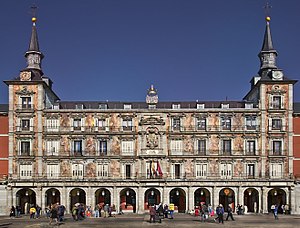Casa de la Panadería
The Casa de la Panadería is the most distinctive building on the north side of Plaza Mayor in Madrid . The middle of the south side, on the other hand, is marked by the architecturally almost identical, but somewhat later built and unpainted Casa de la Carnicería .
history
The exact start of construction is controversial (possibly as early as 1590); the year of completion is noted on a plaque (1619). A second plaque mentions a fire in 1672, the immense damage of which was repaired within 17 months, so that the end of the restoration work can be assumed in 1674. As part of the restoration, the facade was painted with frescoes, which were renewed in 1914; in the years 1988–1992 these were painted over with mythological figures ( Cybele , Proserpina , Bacchus etc.) that are distantly related to the history of the city of Madrid.
function
Originally, the first floor of the building housed the main bakery in old Madrid; Due to the high risk of fire, the rooms were later used as public (calibration) scales, where length measurements could also be compared with one another. In the 18th and 19th centuries, the Real Academia de Bellas Artes de San Fernando was initially housed here, and later the Real Academia de la Historia . At the end of the 19th century, the building took over parts of the city archive. The building is now used by the Spanish Tourism Association; There is an information office on the ground floor.
architecture
Juan Gómez de Mora is named as the executive architect of the Plaza Mayor and the Casa de la Panadería , who took over the work after the death of his famous uncle Francisco de Mora (1610). The four-storey architecture with its corner turrets is based on the Alcázar of Toledo , which - as a single building and due to its exposed location - appears much more majestic. In contrast to the neighboring houses, there are arched arcades on the ground floor. The overlying windows are elaborately framed and have at their fall all decorated with hanging garlands ( festoons ), which was probably added as part of the restoration (1672-74), because the original architecture may have been more severe and more of the unornamented tradition Herrera style .
An elaborate baroque coat of arms from the time of Charles II (reigned 1665–1700), which rests on two reclining lions that have placed their paws on (earth) spheres, is emblazoned above the central arcade . In the upper left field there is the coat of arms of Castile (castle) and León (lion); to the right the coats of arms of Aragón (vertical stripes) and Sicily (vertical stripes and eagles). The oblique stripes of Burgundy and the horizontal stripes of Brabant appear at the bottom left , along with the coats of arms of Flanders and Tyrol . The whole thing is framed by the chain of the Order of the Golden Fleece ; the ram's skin is exactly between the two lions.
Web links
Coordinates: 40 ° 24 ′ 56.9 " N , 3 ° 42 ′ 26.7" W.

